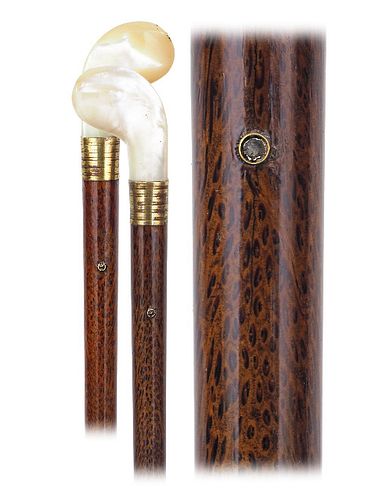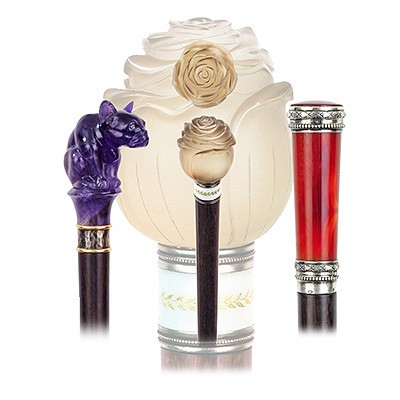Mother of Pearl Erotic Stanhope Dress Cane
Lot 13
About Seller
Kimball Sterling
125 West Market Street
Johnson City, TN 37604
United States
Family-owned and family-run Johnson City Tennessee auction business for 25 years. Selling antiques and collectables for 38 years. Kimball M. Sterling, Inc. was founded and is owned by Kimball and Victoria Sterling, time and again, they have laid solid claim to world-wide attention and renown with an...Read more
Categories
Estimate:
$1,200 - $1,600
Absentee vs Live bid
Two ways to bid:
- Leave a max absentee bid and the platform will bid on your behalf up to your maximum bid during the live auction.
- Bid live during the auction and your bids will be submitted real-time to the auctioneer.
Bid Increments
| Price | Bid Increment |
|---|---|
| $0 | $10 |
| $100 | $25 |
| $500 | $50 |
| $1,000 | $100 |
About Auction
By Kimball Sterling
Dec 3, 2022
Set Reminder
2022-12-03 13:00:00
2022-12-03 13:00:00
America/New_York
Bidsquare
Bidsquare : The 2022 Cane Masterpiece Auction
https://www.bidsquare.com/auctions/kimball-sterling/the-2022-cane-masterpiece-auction-11295
The European Masterpiece Cane Collection Kimball Sterling kimballsterling@earthlink.net
The European Masterpiece Cane Collection Kimball Sterling kimballsterling@earthlink.net
- Lot Description
-Ca 1890 -Pistol shaped mother-of-pearl handle with a shorter round neck and a wider and flattened top with a grooved yellow metal collar on a richly hued and beautifully veined coco palm wood shaft and matched long horn ferrule. Notable is the superior, costly and rarely seen French polish of the shaft. -So-far, so-good, however, what makes this cane singular, is that it is discreetly fitted with an erotic Stanhope in a peep hole located under the collar in what seems to be a pair of discreet round yellow metal eyelets. -The micro lens shows the black and white picture of two nude women sitting side by side in a spicy embrace… Despite endless attempts, it was not possible to capture the two disrobed in a photo, but can assure you that they are there and can be clearly seen by bare eyes. -This amusing and tasteful erotica cane in luxury grade and in a as a good condition as you can ask for is endowed with the crossover appeal of associating with more than one collecting field to augment its desirability. -Expert opinions are unanimous on the French origin and insinuate a costly custom order for the personal pleasure of a Gentleman from the Belle Époque. The discreet look of the cane allowed him to wear it at all occasions, and, in the appropriate time, “disrobe” the device and become the topic of the gathering. -Today, hunting for Stanhopes is addictive precisely because most of these lenses were designed to elude discovery. -H. 3 ¾” x 2 ¼”, O.L. 36” -$1,200-$1,600 -The Stanhope, named after English scientist Lord Stanhope (1753-1816), was an optical novelty that was concealed in nineteenth century jewelry, ornaments and occasionally canes. It consisted of a slim glass rod, less than one-eighth of an inch in diameter, which had one end rounded to form a lens and a tiny round collodion positive photograph cemented to the other end. A small hole was drilled in the jewelry, the Stanhope inserted, and a magnified view of the photograph could then be seen by looking through the lens. Actually the stanhope is the beginning of micro-photography or the microfilm of today. In 1867 a French patent was obtained by Antoine Rochard for objects fitted with Stanhope’s. -For a cane with Stanhope’s see C. Dike, Cane Curiosa, Chapter 10, Photography, page 114, 10/24 and Francis H. Monek’s book, Canes Through The Ages, page 262. -Mother-of-pearl or Nacre is an iridescent substance that forms the lining of the shells of some fresh-water and some salt-water mollusks. This lining protects the shellfish from abrasions and irritants that can get inside the shell. When a foreign object such as a piece of sand enters the shell, the lining protects the oyster and the nacre begins to build up on the foreign object – as such pearls are formed. The shiny nacre that develops on the inside of the shell and essentially “gives birth” to a pearl by transferring that nacre to the foreign object is the mother of pearl. The pearl is the shaped nacre formed on the foreign object.
- Shipping Info
-
Each auction has different shipping terms but the buyer always pays. Shipping will be delayed in this auction due to delay of customs.Canes:After payment has been received we will contact you.
- Buyer's Premium
-



 EUR
EUR CAD
CAD AUD
AUD GBP
GBP MXN
MXN HKD
HKD CNY
CNY MYR
MYR SEK
SEK SGD
SGD CHF
CHF THB
THB


















